|
Serbian (Latin)
Serbian (Cyrillic)
Project Rastko
Arts
Search
Map
Contact
|
Ljiljana Cinkul
CURRENT TRENDS IN GRAPHIC ART
An Experiment in Multiplication with Integrated Graphic Plate
 |
|
Dragan Momirov, Svetovid, 1994.
|
In the intricate Yugoslav artistic scene of the nineties, graphic art undoubtedly represents a significant creative field into which powerful individuals have brought a new sensibility and instituted certain value parameters. Works of the authors singled out in this paper have already been defined by the critics as elements of a movement aimed at a direct revival of modernism.
In order to talk about graphic art in the '90s, one must make a mini-retro survey of the main graphic centre, the so called "Belgrade school". This accepted term refers to institutions like the Belgrade academies of fine and applied arts, the Graficki kolektiv Gallery and its May Graphic Art Exhibition. Since early fifties, the May Graphic Art Exhibition has been a reliable indicator of different tendencies and a promotor of innovations in the medium. Reacting to the problems of the graphic medium in a more liberated and direct approach, artists, including the generation from this last decade of our century, detected a new sensibility in the complex problems of the visual arts of the '80s and '90s. Observed from that angle, the current forms of graphic activities, require a more flexible comprehension and interpretation. Periodically, when they apply new working methods, authors approach a broader and experimental field of this discipline. Related and parallel developments have already been noted in international art as well.
These distinguishing new phenomena, characteristic of the graphic art from the preceding decade bring back the following question – has not the codex of the graphic medium, primarily because of its relationship to certain technological principles, remained most deeply rooted in its own canons, showing the so called loyalty to the medium?... It may be that this loyalty, associated with orthodox graphic artists, can, at least partially, explain why graphic art is largely not present in great projects and problem exhibitions that treat the most pressing questions of visual arts.
On the other hand, the common understanding (fostered by some critics as well) that the graphic medium is a closed system limited by tradition and conventions, has determined a relatively subordinate position for graphic art in the visual arts. Within the context of such unjustified views, wholly disproved by the latest personalities in the medium, graphic art has long been in the wings, almost isolated from the tormentous artistic currents and revolutionary uprisings, and was understood as a promoter of a new, original discourse only in few cases.
These new developments were evident at a number of author exhibitions[1] organized in Belgrade in recent years in order to elaborate either the recent graphic art scene or its individual phenomena. It is quite symptomatic that apart from several official collections of graphic art and the Graphic art cabinet of the National Museum, there is nowhere in Belgrade or Yugoslavia, a permanent exhibition of graphic art. The continuity of graphic art development in the '90s and some aspects of this genuine atmosphere was demonstrated at international exhibitions of graphic art and the discussion organized by the Politika daily paper on "Graphic print or reproduction"[2].
International Graphic Art Exhibitions in Belgrade, Uzice, Leskovac[3]
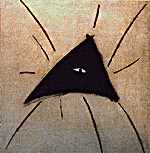 |
|
Anka Burić, Iz ciklusa Na ponoć / From the Czcle In the Midnight, 1996.
|
The nineties in ex-Yugoslavia bear the impression of the fearful howl of war and the imposed international sanctions. Despite the fact that they had dramatic effect on culture as well relevant exhibitions of graphic art in the world remained open for our artists and participants from Yugoslavia received valuable recognition and awards. This period will be remembered for a large number of local graphic art exhibitions, when national selections would ad hoc grow into international. Graphic art once again asserted itself as a powerful medium whose communication qualities facilitated, on the one hand, a link with the world, and domestically, created an impression that we were not totally excommunicated from the international cultural scene. Although organized mostly by invitation and without a more serious conception, these exhibitions carried convincing information about the graphic art production in the world.
In order to perceive the current moment of graphic art in its continuity, one should turn briefly to the art of the preceding decade. Obviously, most of the "new image" art phenomena demonstrated in the works of the new generation of painters and sculptors attained their interpretation in the graphic medium as well. This relates to the story of a generation's natural needs to appropriate its own iconographic and plastic paradigms and to interpret, but also alter, according to its own possibilities, the existing models, formulas and criteria.
In the '80s and '90s a new generation of artists grew up, artists who showed sufficient sensitivity and courage to deal with the current problems of art. They developed their own graphic point of view through their precise feeling for the spirit and hew of time, shifting the viewpoint from the hierarchy of the medium to the sound of new semantic and visual ideas. This change in the visual language of the eighties and the open possibilities offered by postmodernism, were those active incentives for the generation born in the '50s – the main protagonists of the dominant developments in Yugoslav and Serbian graphic art. This chain-system of current graphic movements was joined by the youngest authors who entered the scene in the nineties, as well as a few somewhat older artists. By posing the fundamental question – What is graphic art? – and sometimes approaching the limits of the medium in their own works, individual creative paths lead mostly to a reexamination of the initial feeling for the form and structure of their work. This kind of evolution brought new creative criteria to the graphic workshop itself – a specific laboratory of experience and skill – artists were searching for the signals of lasting values. With a necessary amount of doubt in the standards of the medium, these artists experiment and investigate the relationship between the graphic plate and its quality in the final issue of a work, its format and the extent of its integration into the graphic procedure, because they obviously feel that the plate is equally a work of art as much as its print. However, at the same time, they emphasize the exclusive quality of the print in relation to a diminished if not totally abolished circulation: from an artistic standpoint, circulation is not necessary, it belongs to other factors – exhibitions, collections, the market. With plates incorporated into their prints (Pavic, Ilic, Todovic) each graphic is reduced to one and only, zero print. The graphic print margin has also been abolished and non-standard prints of a few square meters are exposed without glass protection. However, in this age of printing, we still do not have a specialized workshop with skilled printers, so that artists must perform themselves the whole procedure from the treatment of plates to the realization of prints.
 |
|
Zoran Todorović, Trpeza za Maljeviča, Klea i Miroa / Dining Table for Malevich, Klee and Miro, 1995/96.
|
The graphic sign, as an area open to creative innovations was initiated in the '70s by mezzotint, by dry point in early '80s, and by mid-eighties (in identifying those new values) it moved to the traditional techniques of relief print – woodcut and linocut. These attain their idiomatic hew in the new investigations characteristic of the '90s. One could even say that there is an immanent revival of all old graphic techniques and the magical cocktail of their combinations produces a new moment in which it becomes difficult to read the original and its technical properties. In the context of these perspectives of the medium, and a parallel fostering of classical techniques of relief print and multi-coloured graphics, there are experiments with collography, where the performance is more complex and an overlapping of graphic system quite obvious. Namely, collography has taken over the practice of informel art and, by refreshing it with new intellectual aspects of the present time, the art of the eighties clearly activates a new iconography of the original, plastic concept of the work – it makes the thought concrete by making its outer appearance abstract.[4] The audacity of realization, experiments and the freedom expressed in the structuring of a collographic plate is a challenge but also a labyrinth with numerous possibilities – and one has to find the right way out in order to liberate the accumulated creative charge. Another essential fact should be mentioned – in order to make the graphic plate ever bigger – to match large canvases – the graphic print has made a step forward to non-standard, almost monumental formats.
By their consistent and continuous activities a group of graphic artists from the '80s prepared ground for the coming generation. In mid-eighties Biljana Vukovic exhibited her large format graphics with landscape motives as her personal impression of the countryside. Those works, documents of the process and progression of creation, represent in their gestual quality and the atmosphere of condensed energy, a powerful artistic standpoint particularly evident at her exhibition of graphic prints and terra-cotta in 1988, in the Kolarac Gallery. On this occasion, Bojana Buric remarked: "... These works are obviously distinguished by a successful synthesis of, on the one hand, attempts to preserve a medium and, on the other, of efforts to enrich and deepen other ways of visual expression". Unfortunately, the typical eighties' problems were not recognized in her prints at that time, she stayed somewhat aside from the main currents. However, the generation of students who were working with her in the graphics studio of the Belgrade Fine Arts Academy, found the works of Biljana Vukovic very inspiring.
In mid-eighties, Nebojsa Radojev brought some freshness into the graphic art of the so called Belgrade circle. His objective world of conceptual consistency and crystal-like perfection, remained a solitary incident of such a visual concept. Consequently, his exhibition of woodcuts in the Graficki kolektiv Gallery in 1987 was the first signal of the pure graphic sign of the nineties. In the reduced visual poetics of Nebojsa Radojev and his ascetic visual quality, one could find continuity and reference to an older author – Miodrag Rogic. Rogic's paintings and graphics, related to the period of modernism, bear his authentic approach and an emphasis on the essential elements, reaffirming the purity of his plastic concepts. In his following statement: "I want to bring the relationship between black and white to tense limits; to achieve a kind of potential drama", Rogic correctly articulated his own visual credo.
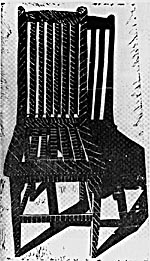 |
|
Nebojša Radojev, Stolica / Chair, 1995.
|
In order to exemplify the typical features of graphic art in the '90s, the traits that undoubtedly express the most lively activity in this medium, we have singled out the following artists: Anka Buric, Branko Pavic, Zoran Todovic, Marija Ilic and Dragan Momirov. Their creative propositions testify of a high degree of individual work and a responsiveness to the new sensibility of graphic art as an area of authentic expression. They share a passion for their work and a confidence in their manual execution in order to overcome the resistance of two opposed energies – their own intellectual-manual action and the material-plate.
Anka Buric (1959) arrived in mid-eighties, with a firm, steady stride. At the present moment, although most of her attention is directed to graphic art, Buric transfers a similar circle of problems to other media – drawing-paintings on large canvases and installations. Her new graphic prints can be defined as a specific journal or chronicle of situations and phenomena with coded messages – there is no more time or need for a disintegrated composition: her attention is focused on an elementary, raw recording. In her search for the character of things in their deformations and their cores, Anka Buric has spontaneously reduced her visual motif to its essence. And so, instead of the human figure and life inside a crowd, there are only stretched out arms, just traces of these arms – pure visual symbols. Her condensed energy is emitted in an ascetically purified sign, and the line, the basic element of her work, directly transmits the weight of intuitive guessing. She feels the real nature of the medium and realizes in dry point technique one of the essential principles of her creative credo – the most direct presence in the medium, with a spontaneous recording of authentic situations and phenomena. In dry point technique she attains the unity of a global visual matrix. Her graphic installation of enormous dimensions at the 1993 May Exhibition, with an underlined plate-print, positive-negative dialogue, was an effective form of an open graphic work.
Branko Pavic (1959) has revived the graphic techniques of relief print (linocut and woodcut) thus integrating the issues of his education in Belgrade and New York. His typical theme is a dialogue with the works from the past (Ghiberti's Door, Stained-glass Windows from Chartres) but he also likes to turn to urban subjects. Pavic drew public attention with his large format graphic and their resounding colorific attractiveness, often done as polyptych, with a strong concentration of the graphic resonance and a brusque coloured tone calmed by cloisonning. At his exhibition in the Salon of the Museum of Contemporary Art in 1990, it was already evident that the plate itself represented an active factor of the show. Namely, he exhibited a large woodcut plate whose parts of black engraving framed a small graphic print in the middle of the plate. His works are contemporary in their spirit and traditional in their formal determinants, but Pavic himself is close to the poetics of expressionism and the spirit of new image painting. He is the only graphic artist who took part in the project called Experiences from Memory IV.[5] To the question what could be realized from a single graphic plate, his response is a challenging experiment with twelve sequences of the work Some Aspects of Life in a Big City. This consistently realized concept has three layers: the plate, the hand-made paper, the relief print of the plate and the circulation. In fact, Pavic opposes woodcut, the oldest graphics technique, to a combination of industrial products like photo-copy or photography. Following his previous investigations, this experiment in multiplication also exposes the plate as an active element of the work, just like its print, the frame and colour, the relief of the hand-made paper, the photocopy. However, Pavic never forgets the basic rule of the graphic medium – the circulation and even quality of the edition. One could define his creative theses as a borderline field of experimental graphic that offers the most unusual forms of an open work.
An important segment of Pavic's artistic biography is his cooperation with Dragoslav Knezevic since 1988. With him he realized several large woodcuts (220x140 cm); at the Faculty of Architecture in Belgrade Pavic is one of the founders, promoters and participants in Workshop 301.
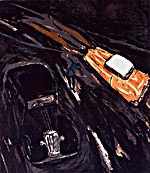 |
|
Marija ilić, Izmeri želju / Mesure the desire, 1992.
|
New potentials of a certain graphic concept and the analytical character of his work define yet another protagonist of Belgrade new graphic art – Zoran Todovic (1958). Todovic works in linoleum because of its manual spontaneity, the quality of direct execution and the expressiveness of the material. The author himself explains: "Linocutting for me represents drawing in linoleum; it possesses a different sensitivity in relationship to articulative possibilities of other techniques." Undoubtedly, with linocutting one has no fear of mistakes, additional interventions can always be made, the surface of linoleum accepts collage and, as the author himself says, it is at halfway point to collography. New experiments in linocutting, in a certain way, shift Todovic's optical standpoint: from the initial, standard formats of ten years ago, the graphic sheet, responding to the challenges of these different Zptions, widens horizontally and vertically and reaches the dimensions of a mural painting measuring several square meters. Later, these visual entities give up their place to a free field where a lively contour underlines the internal impulse of the graphic sheet. These segments of regular rhythm that multiply like modular systems are experienced as intensive representations of different visual sensations that reminisce the repetition of a musical phrase. Such a large graphic composition containing twenty-five elements, including its plate, was exhibited at the 36th October Salon, and brought him the prize for graphic art.
Simplicity, resoluteness and a powerful personality are characteristic of the creative personality of Marija Ilic (1959). The essential question – More or less than a graphic print? – she asked first of herself, then of her audience at the exhibition held in the Graficki kolektiv Gallery in 1992, before she went to the Netherlands. She was attracted to collography by its free model and seductive feasibilities of visual play. Intuitively and emotionally, in experimenting with collography, she revealed the exciting force of liberated energy; her multicoloured relief prints crystallize matter and form, as well as an imaginary space and structure, her energetic gestuality and sensitivity. Her wish to incorporate all the levels of the creative process and integrate them into the final form of the work, is expressed in her synchronized course of action – her serial works with the plate incorporated into the graphic sheet. Thereby the classical principle that graphic plate has its own life independent of the prints is once again shifted to the benefit of its prolonged effectiveness. Marija Ilic uses the positive and negative poles of the process (plate-print) in order to indicate their symmetrical existence and their balanced dialogue, thus revealing the male and female principles of diabolical rivalry and eternal variation of yes and no. In fact, the artist polarizes the character of one and the same being. Like another reality, the plate is part of the print. It corresponds with one or more of its repeated positives, indicating that the quality of multiplications, as a feature of the graphic medium, is able to win the victory over another space and get a new meaning. In her play of linking different variants of one print (plate), Marija Ilic joins the authors who investigate the borderline areas of the graphic medium, and treat the graphic matter and its textuality as the central point of their engagement.
Dragan Momirov (1962) is one of those artists whose creative work comes close to what could be called – liberation. His graphics should be observed within the duality of the contemporary spirit and the classical means; an intersection of momentary bold ideas and current problems. In applying the general laws of artistic practice and reducing the superfluous to the minimum, Dragan Momirov reveals the clear contours of his creative physiognomy. He sees the yet unknown traces in the lapidary qualities of stone, the thematic framework of his work, and searches for the archetypal. There is an influence of the good qualities of the Belgrade school of graphic art in his work – having matured in his dedication to the medium it accelerated the time of fermentation and changes from the state of looking into the state of seeing. In an environment of permanent creative challenge – full of archetypal models of mythical Slavonic symbols and magical archeological artifacts – Momirov is searching, in fact, for a quintessence of a higher order. This could also be said of his big triptych composition exhibited at the 34th October salon: in a free interpretation of graphic nuclei he poses the question of the effectuation of a certain phenomenon or form. The monumental quality of his works yet of standard dimensions, naturally leads to their physical enlargement, and they become even more convincing as petrified fragments. In the triad of space, time and matter, he demonstrates the degree of specificity of the created system of signs. The language of form, as an essential property of Momirov's work, is marked by compactness, signalization, visual qualities and contrasts; in the fore front of this creative project there is a need to standardize the (chosen) graphic technology (relief print and line etching) with the character of his artistic expression.
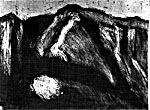 |
|
Biljana Vuković, Tasos IV / Thassos IV, 1996.
|
The complex of the current graphic phenomena would never be complete without a group of authors born mostly in the '60s, whose maturation and the search for visual identity is also marked by the reflection of time. They are engrossed in investigations of form and structure, gesture and new informel, and their poetics are parallelly present in painting as well; they enter the domain of referential phenomena on the map of the scattered contemporary events in art. There is an evident line of research into the layers of the visual; it creates a complex expressiveness that accumulates in the obvious presence of the figurative sign (Lidija Antanasijevic, Dusica Kirjakovic, Milica Andjelkovic) or in the saturation of an almost abstract model (Biljana Sevo). In the various forms of this personal creative drama there is a metaphoric quality of plastic articulation (Milan Stasevic, Zarko Smiljanic), a methodological consistency of Byzantine provenance (Zorica Tasic), a direct reference to a comic strip model of mass culture (Slobodan Bojovic), associative allusions to the objective world (Nevenka Stojsav-ljevic, Branislav Fotic, Petar Gajic), gestual recordings (Miodrag Mladjovic), an atmosphere of spontaneity in new informel (Zoran Dimovski, Branko Rakovic). Within the same context there is a synchronous current of different attitudes and decisions: in experiments with hand-made paper and the expression reduced to an ultimately sophisticated geometric order (Slobodan Knezevic), in woodcut as a vibrating painted surface (Aleksandar Rasulic) and the variants of the primary graphic element-sign (Slavko Milenkovic, Dragan Kicovic).
It is well-known that the choice of artistic form is never accidental; loyalty to certain ideals equals an active search for a spiritual charge the work carries along in time. It is also believed that graphic art is a hard medium, and its execution is neither easy nor revealing. On the contrary. It was Kirchner who advised, after his personal experience, that "only those artists who love and know their craft should indulge in graphics". This selective review of the creative moment in the graphic art of the '90s underlines only the current trends. The current steered by strong individuals who were able to anticipate and feel the signals and the spirit of the new art in the last decade of the twentieth century, is marked by investigations in the domain of the potentials of the medium – a plastic organization of the work and a combination of old and new technologies. Anka Buric, Branko Pavic, Zoran Todovic, Marija Ilic and Dragan Momirov belong to a creative nucleus that implements its correlation with time in a disconnected system of the intellectual subject-matter of art by their renewed belief in the purity of visual thinking and the language of form. It is quite logical that this unusual collective chronicle of graphic phenomena in the '90s is mostly about the artists of almost forty years of age, since they are the most active once both biologically and creatively.
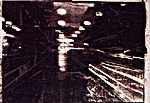 |
|
Branko Pavić, Raskrsnica / Crossroads, 1995.
|
Although graphic art today belongs to a broader field of visual arts it has not had a dominant character in the art of this decade. However, a strengthened self-consciousness within the medium is diagnosed as a determining factor both by the authors and a circle of knowledgeable critics and art historians.
About graphic art as an area of authentic expression (as exemplified in his own works) Branko Pavic said in an interview: "In any way, a graphic print as a work of art at its highest points is in no way more exceptional than music, architecture or painting. Only their linguistic codes are different and therefore I approach it freely". Let this authentic statement of an author end this resume on graphic art in the '90s.
Notes
1 Lj. Cinkul, Sedam savremenih graficara (Seven contemporary Graphic Artists), XXXII October Salon, 1991; Z. Todovic, Lj. Cinkul, Izazov linogravure (The Challenge of Lino), XXXIII October Salon, 1992; Lj. Slijepcevic, Refleksije nove slike u grafici (Reflexions of New Image in the Graphic Art) , Salon of the Museum of Contemporay Art, Belgrade, 1994; Lj. Slijepcevic, Mitoloske predstave u novoj grafici (Mythological Scenes in the new Graphic), Salon of the Museum of Contemporary Art, Belgarde, 1995.
2 Polemics about that question were held in the daily newspaper Politika at the begining of 1991 without particular result.
3 International Exhibition of Small Graphic, Belgrade, 1993 and 1994; Third Graphic Biennial, Belgrade, 1994; Second Graphic Biennial, Uzice, 1995; International Biennial of Small Graphic, Leskovac, 1995.
4 At the begining of 1990 the American artist Den Elison, awared at the XVII International Graphic Biennial in Ljubljana in 1987, exhibited in the Gallery Sebastian in Belgrade. He was the guest at the VIIIth Open Graphic Workshop in the National Museum and at the Graphic department of the Faculty of Fine Arts. His large scale collographies from the cycle Documents of the New World had a great imapct on our artists as the example of different model of graphic thinking.
5 Branko Pavic, Some Aspects of the Life in a Big City, Belgrade, 1994; concept and realization of the project Experiences from Memory: Irina Subotic and Gordana Stanisic, National Museum, Belgrade, 1994-1995.
|



